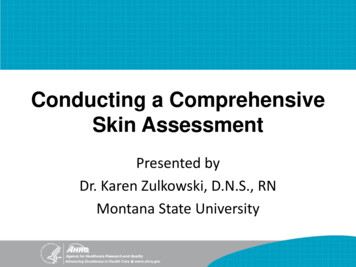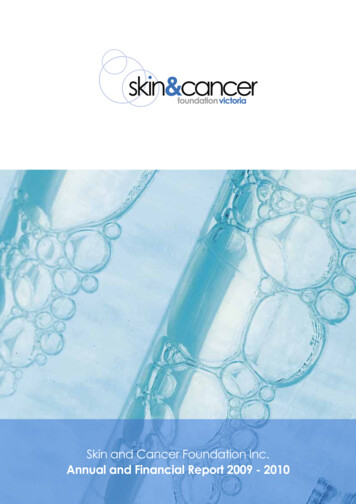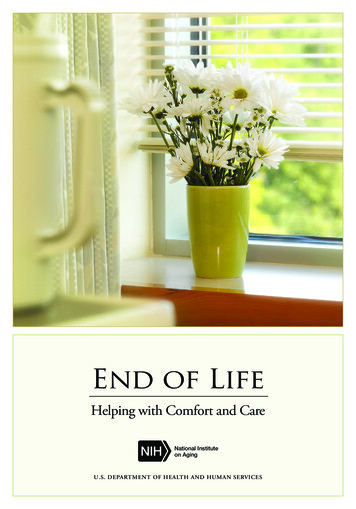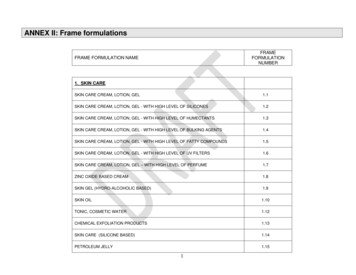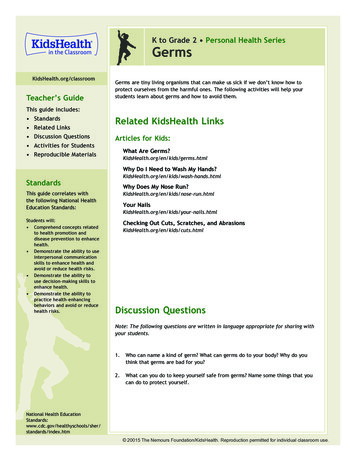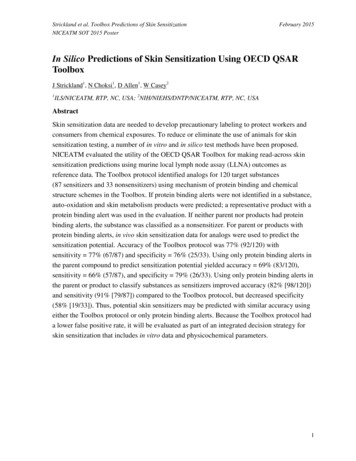
Transcription
Strickland et al. Toolbox Predictions of Skin SensitizationNICEATM SOT 2015 PosterFebruary 2015In Silico Predictions of Skin Sensitization Using OECD QSARToolboxJ Strickland1, N Choksi1, D Allen1, W Casey21ILS/NICEATM, RTP, NC, USA; 2NIH/NIEHS/DNTP/NICEATM, RTP, NC, USAAbstractSkin sensitization data are needed to develop precautionary labeling to protect workers andconsumers from chemical exposures. To reduce or eliminate the use of animals for skinsensitization testing, a number of in vitro and in silico test methods have been proposed.NICEATM evaluated the utility of the OECD QSAR Toolbox for making read-across skinsensitization predictions using murine local lymph node assay (LLNA) outcomes asreference data. The Toolbox protocol identified analogs for 120 target substances(87 sensitizers and 33 nonsensitizers) using mechanism of protein binding and chemicalstructure schemes in the Toolbox. If protein binding alerts were not identified in a substance,auto-oxidation and skin metabolism products were predicted; a representative product with aprotein binding alert was used in the evaluation. If neither parent nor products had proteinbinding alerts, the substance was classified as a nonsensitizer. For parent or products withprotein binding alerts, in vivo skin sensitization data for analogs were used to predict thesensitization potential. Accuracy of the Toolbox protocol was 77% (92/120) withsensitivity 77% (67/87) and specificity 76% (25/33). Using only protein binding alerts inthe parent compound to predict sensitization potential yielded accuracy 69% (83/120),sensitivity 66% (57/87), and specificity 79% (26/33). Using only protein binding alerts inthe parent or product to classify substances as sensitizers improved accuracy (82% [98/120])and sensitivity (91% [79/87]) compared to the Toolbox protocol, but decreased specificity(58% [19/33]). Thus, potential skin sensitizers may be predicted with similar accuracy usingeither the Toolbox protocol or only protein binding alerts. Because the Toolbox protocol hada lower false positive rate, it will be evaluated as part of an integrated decision strategy forskin sensitization that includes in vitro data and physicochemical parameters.1
Strickland et al. Toolbox Predictions of Skin SensitizationNICEATM SOT 2015 PosterFebruary 2015Introduction Allergic contact dermatitis (ACD) is a skin reaction, characterized by localized redness,swelling, blistering, or itching (Figure 1), that can develop after repeated direct contactwith a skin sensitizer. Skin sensitizers include commonly used substances such asneomycin and formaldehyde. National and international regulatory authorities require testing of pesticides, personalcare products, and other products to assess their potential to cause ACD. The results ofthese tests are used to determine appropriate labeling to ensure safe use and handling. During the past 15 years, the Interagency Coordinating Committee on the Validation ofAlternative Methods (ICCVAM) and the National Toxicology Program InteragencyCenter for the Evaluation of Alternative Toxicological Methods (NICEATM) haveevaluated a wide range of in vivo, in vitro, and in silico approaches to identify potentialskin sensitizers. This poster evaluates the use of QSAR Toolbox v3.2, a freely available software package,for predicting skin sensitization hazard without using animals.Figure 1Skin Sensitization ReactionThe Skin Sensitization Adverse Outcome Pathway 2Although the development of skin sensitization is a complex process, a well-definedadverse outcome pathway (AOP) has been developed for substances that producesensitization by covalently binding to proteins (OECD 2012) (Figure 2).
Strickland et al. Toolbox Predictions of Skin SensitizationNICEATM SOT 2015 PosterFigure 2February 2015Adverse Outcome Pathway for Skin SensitizationQSAR Toolbox The Organisation for Economic Co-operation and Development (OECD) developed theQSAR Toolbox software to make quantitative structure–activity relationship (QSAR)technology readily accessible, more transparent, and less costly (OECD 2014), therebyincreasing regulatory acceptance of QSAR analyses. The QSAR Toolbox software is freely available nt/theoecdqsartoolbox.htm QSAR Toolbox can be used to evaluate chemicals, including metals and the full range oforganic functional groups and protein binding mechanisms, that are relevant to skinsensitization (ECHA 2014). QSAR Toolbox allows considerable user control over the prediction and output byincluding in its workflow the opportunity to- Identify relevant target chemical structural characteristics and potential mechanism ormode of action3
Strickland et al. Toolbox Predictions of Skin SensitizationNICEATM SOT 2015 PosterFebruary 2015- Identify other chemicals that have the same structural characteristics and/ormechanism or mode of action and existing data of interest (e.g., skin sensitization testresults)- Use existing experimental data to fill any data gaps In this evaluation, QSAR Toolbox was used to predict skin sensitization via two methods:- Method 1 assessed the ability of a substance to produce Key Event 1, the molecularinitiating event in the AOP (Figure 2), by reporting the presence of protein bindingalerts using two approaches: Approach 1 reported the presence of protein binding alerts only for the targetsubstance.Approach 2 reported the presence of protein binding alerts for the targetsubstance or its auto-oxidation or skin metabolism products- Method 2 assessed the ability of a substance to produce Key Event 4 (a positiveresult in the murine local lymph node assay [LLNA]) and the adverse outcome in theAOP (a skin sensitization reaction in guinea pig and human tests) (Figure 2) by usinga read-across prediction to classify substances as sensitizers or nonsensitizersDatabase 4Of the 120 substances included in this evaluation, 73% (87/120) were classified assensitizers by the LLNA and 27% (33/120) were classified as nonsensitizers. Thedistribution of LLNA potency for the evaluated substances is shown in Figure 3.
Strickland et al. Toolbox Predictions of Skin SensitizationNICEATM SOT 2015 PosterFigure 3February 2015Distribution of LLNA EC3 Values for 120 SubstancesAbbreviations: EC3 estimated effective concentration that produces a stimulation index of 3, the threshold fora positive response in the LLNA; LLNA murine local lymph node assay; N nonsensitizers. Haptens are substances with the potential to induce skin sensitization withoutmodification or metabolism. Prehaptens require oxidation in order to elicit a skinsensitization reaction and prohaptens require metabolism. The distribution of prehaptensand prohaptens among the 87 sensitizers in the 120-substance database is shown inFigure 4.5
Strickland et al. Toolbox Predictions of Skin SensitizationNICEATM SOT 2015 PosterFigure 4February 2015Distribution of Prehaptens and Prohaptens for 87 LLNA SensitizersAbbreviation: LLNA murine local lymph node assay. 6The distribution of substances among product categories is shown in Table 1.
Strickland et al. Toolbox Predictions of Skin SensitizationNICEATM SOT 2015 PosterTable 1February 2015Distribution of 120 Substances in the Database Among ProductCategoriesPercentage ofSubstancesaNumber of SubstancesManufacturing49%59Food additive37%44Pharmaceutical28%33Intermediate in chemicalsynthesis25%30Fragrance agent20%2418%2117%2016%1915%18Solvent7%8Household product6%7Plastic2%2Rubber1%1Antioxidant1%1Product CategoryPesticide (other)bPersonal care productCosmeticPesticide (antimicrobial)baTotal of all percentages exceeds 100% because most substances were associated with more than one productcategory.bTwenty-six of the 39 pesticides (antimicrobials plus other pesticides) are currently registered with the U.S.Environmental Protection Agency.Protocol Training materials for QSAR Toolbox v3.2 were used to develop a read-across protocolto predict the skin sensitization hazard of 120 substances.7
Strickland et al. Toolbox Predictions of Skin SensitizationNICEATM SOT 2015 PosterFigure 5 February 2015QSAR Toolbox Protocol for Skin Sensitization PredictionsIn the first step of the protocol, QSAR Toolbox assesses the likelihood that the targetsubstance will bind to protein using four structural feature recognition (“alert”) systemsfor protein binding (Figure 5, Step 1).- QSAR Toolbox recognizes structural features that have been identified as binding toskin proteins using four alert systems, termed “profilers.” Three of the profilers aregeneral mechanistic profilers and one is an endpoint-specific (i.e., skin sensitization)mechanistic profiler (Figure 6). 8Protein binding by OASIS v1.2 identifies whether a substance contains any of101 structural features (alerts) in 11 mechanistic domains that are responsible forthe interaction with proteins.Protein binding by OECD determines whether a substance binds to proteinsusing a scheme that has five overarching mechanistic domains related to structuralalerts grouped by the presence of a common reactivity site into mechanistic alerts.This profiler has 102 categories of protein binding that includes 16 mechanistic
Strickland et al. Toolbox Predictions of Skin SensitizationNICEATM SOT 2015 Poster February 2015alerts (e.g., ring-opening acylation) that cover 52 structural alerts (e.g.,alpha-lactams).Protein binding potency assesses the likelihood that the target substance willcovalently bind with the thiol group of glutathione. The profiler contains49 Michael addition and 46 bimolecular nucleophilic substitution (SN2)categories. The 95 structural alerts are separated into five potency categories ofreactivity: extremely, highly, moderately, slightly, and suspect.Protein binding alerts for skin sensitization by OASIS v1.2 is the endpointspecific profiler that evaluates whether a substance binds to proteins. Compared tothe protein binding by OASIS v1.2 profiler (discussed in the first bullet above),this profiler accounts for the inhibition of protein binding in the skin, produced byelectronic and steric factors, for substances with protein binding alerts. It uses100 structural alerts that have been categorized into 11 mechanistic domains.Each mechanistic domain has more than two mechanistic alerts.- The protocol for Method 1, Approach 1 ends here. Figure 6 Substances with protein binding alerts were classified as sensitizers.Substances without protein binding alerts were classified as nonsensitizers.QSAR Toolbox Protein Binding ProfilersIf QSAR Toolbox identified no protein binding alerts for the target substance, a furtherassessment was conducted to determine if the substance might be a pre- or prohapten.The autoxidation and skin metabolism modules were used to generateoxidation/metabolism products (Figure 5, Step 1a). These products were then profiled asabove for protein binding alerts. If none were identified, the target substance wasclassified to be a nonsensitizer (Figure 5, Step 1b).- The protocol for Method 1, Approach 2 ends here.9
Strickland et al. Toolbox Predictions of Skin SensitizationNICEATM SOT 2015 Poster February 2015Substances with products that had protein binding alerts were classified assensitizersSubstances that had products without protein binding alerts were classified asnonsensitizers. If protein binding alerts were identified in parent substances or products, QSAR Toolboxformed a category of similar substances with in vivo skin sensitization data based onstructural similarity (Figure 5, Step 2). A read-across algorithm was then applied to the in vivo skin sensitization data (mouse,guinea pig, or human) of the category members to predict the skin sensitization hazard ofthe target substance (Figure 5, Step 3). The read-across algorithm uses the skinsensitization outcome that appears most often for the five nearest neighbors, based on logKow, to predict the skin sensitization hazard of the target substance. Substances with dissimilar mechanisms of protein binding (compared with the targetsubstance) were then eliminated to refine the skin sensitization hazard prediction (Figure5, Step 4).- The protocol for Method 2 ends here with the read-across prediction. All skin sensitization predictions were evaluated for concordance with LLNA outcomes.Results The performance statistics for the three methods are shown in Table 2.Table 2Performance Statistics with Respect to LLNA OutcomesMethodAccuracySensitivityFalseNegative RateSpecificityFalse PositiveRateMethod 1,Approach 1a69% (83/120)66% (57/87)35% (30/87)79% (26/33)21% (14/33)Method 1,Approach 2b82% (98/120)91% (79/87)9% (8/87)58% (19/33)42% (14/33)Method 2c77% (92/120)77% (67/87)23% (20/87)76% (25/33)24% (8/33)Abbreviation: LLNA murine local lymph node assay.aMethod 1, Approach 1 used only the presence of protein binding alerts in the target substance to predictsensitization potential.bMethod 1, Approach 2 used the presence of protein binding alerts in either the target compound orauto-oxidation or skin metabolism products to predict sensitization potential.10
Strickland et al. Toolbox Predictions of Skin SensitizationNICEATM SOT 2015 PostercFebruary 2015Method 2 used in vivo skin sensitization data in a read-across algorithm. Read-across predictions for fivesubstances (4-nitrobenzyl bromide, ethylene glycol dimethacrylate, farnesal, glyoxal, andphenylacetaldehyde) were unreliable because the log Kow of each target substance was outside the range ofthe nearest neighbors. However, the predictions were concordant with LLNA outcomes.Misclassified Substances for Method 2 Read-across The QSAR Toolbox read-across protocol (Method 2) misclassified 28 substances. Table 3 lists characteristics of the 20 false negatives (LLNA sensitizers that weremisclassified as nonsensitizers).- Nine of the false negatives were weak LLNA sensitizers (EC3 10%), two weremoderate LLNA sensitizers (1% EC3 10%), and nine were strong sensitizers(EC3 1%).- Four false negatives were prohaptens and one was a pre/prohapten. Of these fivesubstances, three were strong LLNA sensitizers.- 60% (12/20) of the false negatives had no protein binding alerts for the parentsubstances, and 40% (8/20) had no protein binding alerts for either the parent or anauto-oxidation product or skin metabolite.- Human data were available for 16 of the false negatives; 11 substances are humanskin sensitizers. Thus, five substances are false positive in the LLNA (i.e., theread-across protocol may be more relevant to human sensitization).11
Strickland et al. Toolbox Predictions of Skin SensitizationNICEATM SOT 2015 PosterTable 3February 2015Twenty Substances with False Negative QSAR Toolbox Read-across Predictions (Method 2)Chemical tProteinBinding AlertAny ProteinBindingAlertGeometricMean c acid112-05-0158.24NNoNo35POSNEGNAUndecylenic acid112-38-9184.28NNoNo19.4POSNEGNALauryl l e -207106.08NNoNo95.8POSNEGNEGOxalic acid144-62-790.05NNoNo0.10POSNEGNASodium lauryl obenzenesulfonic l ureaAbietic acid514-10-3302.46ProNoYes15POSNEGPOSPenicillin G61-33-6334.39NYesYes17.4POSNEGPOSSalicylic acid69-72-7138.12NNoNo12.2POSNEGNEG12
Strickland et al. Toolbox Predictions of Skin SensitizationNICEATM SOT 2015 PosterFebruary 2015Chemical tProteinBinding AlertAny ProteinBindingAlertGeometricMean ltbBenzalkonium hyl 91-64-5146.14NYesYes29.6POSNEGPOSBenzoyl ations: CASRN Chemical Abstracts Service Registry Number; EC3 estimated effective concentration that produces a stimulation index of 3, thethreshold for a positive response in the LLNA; LLNA murine local lymph node assay; NA not available; N hapten; NEG negative; POS positive;Pro prohapten; Pre/Pro pre/prohapten.aFrom the NICEATM LLNA database at mlbFrom ICCVAM (2011) or Basketter et al. (2014).13
Strickland et al. Toolbox Predictions of Skin SensitizationNICEATM SOT 2015 Poster February 2015Table 4 shows the eight LLNA nonsensitizers that were misclassified as sensitizers (falsepositives) by the read-across protocol (Method 2).- Only 38% (3/8) of the false positives had protein binding alerts for the parentsubstances, but 100% (8/8) had protein binding alerts for the parent or anauto-oxidation product or skin metabolite.- Two of the false positives had discordant results in multiple LLNA tests, although themajorities were negative. Aniline had 4/9 positive tests.Streptomycin had 1/5 positive tests.- Human data were available for 6/8 false positives. Of these, 3 substances are humanskin sensitizers.14
Strickland et al. Toolbox Predictions of Skin SensitizationNICEATM SOT 2015 PosterTable 4February 2015Eight Substances with False Positive Toolbox Read-across Predictions (Method 2)Chemical NameCASRNMolecularWeight (g/mol)Parent ProteinBinding AlertAny 7NoYesNEGPOSNEGEthyl -86-5147.18NoYesNEGPOSNAStreptomycin methacrylateAbbreviations: CASRN Chemical Abstracts Service Registry Number; LLNA murine local lymph node assay; NA not available; NEG negative;POS positive.aFrom the NICEATM LLNA database at mlbFrom ICCVAM (2011) or Basketter et al. (2014).15
Strickland et al. Toolbox Predictions of Skin SensitizationNICEATM SOT 2015 PosterFebruary 2015Conclusions For the database used in this evaluation, using protein binding alerts to predict LLNAoutcome yielded the best performance when alerts for both the target substance and itsauto-oxidation products or skin metabolites were considered.- When using alerts for only the target substances (Method 1, Approach 1), accuracywas 69%, sensitivity was 66%, and specificity was 79%.- When using alerts for target substances or auto-oxidation products or metabolites(Method 1, Approach 2), accuracy increased to 82% and sensitivity increased to91%, but specificity decreased to 58%. Using the read-across protocol to predict LLNA outcome (Method 2) provided a morebalanced evaluation of positives and negatives.- With this approach, accuracy was 77%, sensitivity was 77% and specificity was 76%. The results from the read-across protocol were used in an evaluation of an integrateddecision strategy for skin sensitization that includes in vitro data and physicochemicalparameters (see Matheson et al. Abstract 421, Poster Board 108 in this session)ReferencesBasketter DA, Alépée N, Ashikaga T, Barroso J, Gilmour N. et al. 2014. Categorization ofchemicals according to their relative human skin sensitizing potency. Dermatitis 25:11-21.ECHA. 2014. Illustrative examples with the OECD QSAR Toolbox workflow. Part 1:Introductory note. [Internet]. Helsinki, Finland:European Chemical Agency. 655633/illustrative example qsar part1 en.pdfICCVAM. 2011. ICCVAM Test Method Evaluation Report: Usefulness and Limitations ofthe Murine Local Lymph Node Assay for Potency Categorization of Chemicals CausingAllergic Contact Dermatitis in Humans. NIH Publication No. 11-7709. Research TrianglePark, NC: National Institute of Environmental Health Sciences.OECD. 2012. OECD Series on Testing and Assessment No. 168. The Adverse OutcomePathway for Skin Sensitisation Initiated by Covalent Binding to Proteins. Part 1: ScientificAssessment. Paris:OECD Publishing.OECD. 2014. The OECD QSAR Toolbox [Internet]. OECD Publishing. assessment/theoecdqsartoolbox.htm.16
Strickland et al. Toolbox Predictions of Skin SensitizationNICEATM SOT 2015 PosterFebruary 2015AcknowledgementsThe Intramural Research Program of the National Institute of Environmental Health Sciences(NIEHS) supported this poster. Technical support was provided by ILS under NIEHScontract HHSN27320140003C.The views expressed above do not necessarily represent the official positions of any Federalagency. Since the poster was written as part of the official duties of the authors, it can befreely copied.A summary of NICEATM activities at the 2015 SOT Annual Meeting is available on theNational Toxicology Program website at http://ntp.niehs.nih.gov/go/742110.17
QSAR Toolbox can be used to evaluate chemicals, including metals and the full range of organic functional groups and protein binding mechanisms, that are relevant to skin sensitization (ECHA 2014). QSAR Toolbox allows considerable user control over the prediction a

